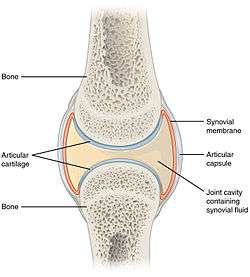Synovial joint
| Synovial joint | |
|---|---|
 Structure of synovial joint | |
 Types of synovial joints.
Clockwise from top-right: Ball and socket joint, Condyloid joint, Plane joint, Saddle joint, Hinge joint and Pivot joint. | |
| Details | |
| Identifiers | |
| Latin | junctura synovialis |
| TA | A03.0.00.020 |
| FMA | 7501 |
A synovial joint, also known as diarthrosis, joins bones with a fibrous joint capsule that is continuous with the periosteum of the joined bones, constitutes the outer boundary of a synovial cavity, and surrounds the bones' articulating surfaces. The synovial (or joint) cavity is filled with synovial fluid. The joint capsule is made up of an outer layer, the articular capsule, which keeps the bones together structurally, and an inner layer, the synovial membrane, which seals in the synovial fluid.
They are the most common and most movable type of joint in the body of a mammal. As with most other joints, synovial joints achieve movement at the point of contact of the articulating bones.
Structure
Synovial joints contain the following structures:
- Synovial cavity: all diarthroses have the characteristic space between the bones that is filled with synovial fluid
- Joint capsule: the fibrous capsule, continuous with the periosteum of articulating bones, surrounds the diarthrosis and unites the articulating bones; the joint capsule consists of two layers - (1) the outer fibrous membrane that may contain ligaments and (2) the inner synovial membrane that secretes the lubricating, shock absorbing, and joint-nourishing synovial fluid; the joint capsule is highly innervated, but without blood and lymph vessels, and receives nutrition from the surrounding blood supply via either diffusion (a slow process) or by convection, a far more efficient process achieved through exercise.
- Articular cartilage: the bones of a synovial joint are covered by this layer of hyaline cartilage that lines the epiphyses of joint end of bone with a smooth, slippery surface that does not bind them together; articular cartilage functions to absorb shock and reduce friction during movement.
Many, but not all, synovial joints also contain additional structures:[1]
- Articular discs or menisci - the fibrocartilage pads between opposing surfaces in a joint
- Articular fat pads - adipose tissue pads that protect the articular cartilage, as seen in the infrapatellar fat pad in the knee
- Tendons[1] - cords of dense regular connective tissue composed of parallel bundles of collagen fibers
- Accessory ligaments (extracapsular and intracapsular) - the fibers of some fibrous membranes are arranged in parallel bundles of dense regular connective tissue that are highly adapted for resisting strains to prevent extreme movements that may damage the articulation
- Bursae - saclike structures that are situated strategically to alleviate friction in some joints (shoulder and knee) that are filled with fluid that is similar to synovial fluid[2]
The bone surrounding the joint on the proximal side is sometimes called the plafond, especially in the talocrural joint. A damage to this occurs in a Gosselin fracture.
Blood supply
The blood supply of a synovial joint is derived from the arteries sharing in the anastomosis around the joint.
Types
There are six types of synovial joints.[3] Some are relatively immobile, but are more stable. Others have multiple degrees of freedom, but at the expense of greater risk of injury.[3] In ascending order of mobility, they are:
| Name | Example | Description |
|---|---|---|
| Gliding joints (or plane joints) | carpals of the wrist, acromioclavicular joint | These joints allow only gliding or sliding movements, are multi-axial such as the articulation between vertebrae. |
| Hinge joints | elbow (between the humerus and the ulna) | These joints act as a door hinge does, allowing flexion and extension in just one plane |
| Pivot joints | atlanto-axial joint, proximal radioulnar joint, and distal radioulnar joint | One bone rotates about another |
| Condyloid joints (or ellipsoidal joints) | wrist joint (radiocarpal joint) | A condyloid joint is where two bones fit together with an odd shape (e.g. an ellipse), and one bone is concave, the other convex; some classifications make a distinction between condyloid and ellipsoid joints;[4][5] these joints allow flexion, extension, abduction, and adduction movements (circumduction). |
| Saddle joints | Carpometacarpal or trapeziometacarpal joint of thumb (between the metacarpal and carpal - trapezium), sternoclavicular joint | Saddle joints, which resemble a saddle, permit the same movements as the condyloid joints but allow greater movement |
| Ball and socket joints
"universal Joint" |
shoulder (glenohumeral) and hip joints | These allow for all movements except gliding |
| Compound joints[6][7] / modified hinge joints | knee joint | condylar joint (condyles of femur join with condyles of tibia) and saddle joint (lower end of femur joins with patella) |
Function
The movements possible with synovial joints are:
- abduction: movement away from the mid-line of the body
- adduction: movement toward the mid-line of the body
- extension: straightening limbs at a joint
- flexion: bending the limbs at a joint
- rotation: a circular movement around a fixed point
Clinical significance
- The shape of articular surfaces
- Capsule and ligaments
- Muscle tone
- Gravity
- Atmospheric pressure
References
- 1 2 Drake et al. (2009) Gray's Anatomy for Students, 2nd Edition, Skeletal system, p.21
- ↑ Tortora & Derrickson () Principles of Anatomy & Physiology, 12th Edition, Pub: Wiley & Sons
- 1 2 Umich 2010 couse, Module - Introduction to Joints
- ↑ Rogers, Kara (2010) Bone and Muscle: Structure, Force, and Motion p.157
- ↑ Sharkey, John (2008) The Concise Book of Neuromuscular Therapy p.33
- ↑ Moini (2011) Introduction to Pathology for the Physical Therapist Assistant pp.231-2
- ↑ The Biophysical Foundations Of Human Movement (2005) By Bruce Abernethy pp.23, 331
| Wikimedia Commons has media related to Synovial joints. |